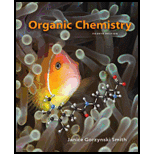
Concept explainers
(a)
Interpretation:
To draw the organic products formed when 4-octyne is treated with given reagent.
Concept introduction:
Reduction of an
(b)
Interpretation:
To draw the organic products formed when 4-octyne is treated with given reagent.
Concept introduction:
Reduction of an alkyne by the addition of H2 to one or both of the pi bonds. When an alkyne is treated with two or more equivalents of H2 and using the Pd catalyst, reduction of both the pi bonds occurs. Thus Palladium metal is too active a catalyst to allow the hydrogenation of an alkyne to stop after one equivalent of H2. Thus Lindlar catalyst is used to reduce the triple to double bond.
(c)
Interpretation:
To draw the organic products formed when 4-octyne is treated with given reagent.
Concept introduction:
Reduction of an alkyne by the addition of H2 to one or both of the pi bonds. When an alkyne is treated with two or more equivalents of H2 and using the Pd catalyst, reduction of both the pi bonds occurs. Using the Pd catalyst form the cis alkene or alkane product but not the trans alkene. Thus another reagent is used to reduce the triple to double in a trans form.
(d)
Interpretation:
To draw the organic products formed when 4-octyne is treated with given reagent.
Concept introduction:
Oxidative cleavage of an alkene breaks both the sigma and pi bonds of the double bond to form two carbonyl groups. Depending on the number of R groups bonded to the double bond, oxidative cleavage yields either
Want to see the full answer?
Check out a sample textbook solution
Chapter 12 Solutions
Organic Chemistry
- Draw the organic products formed when cyclopentene is treated withfollowing reagent. [1] LiAlH4; [2] H2Oarrow_forwardWhat would be the organic product for each reaction?arrow_forwardWhat products (including stereoisomers, if applicable) are formed from the reaction of 3-bromo-3-methylpentane: a. with HO-? b. with H2O?arrow_forward
- Finish the indicated reaction by filling in and starting materials, reagents or products as needed arrow_forwardDevise a synthesis of each alkene using a Wittig reaction to form the double bond. You may use benzene and organic alcohols having four or fewer carbons as starting materials and any required reagents.arrow_forwardExplain why the addition of HBr to alkenes A and C is regioselective, forming addition products B and D, respectively.arrow_forward
- Explain why the addition of HBr to alkenes A and C is regioselective,forming addition products B and D, respectively.arrow_forwardWhat reagents would you use to prepare the next alkenearrow_forward6- Prepare cis-2-butane using propyne, and alkyl halide. Use any other reagents needed.7- Use 4-Octene as the only source of carbon in the synthesis of Butanal. Use anyinorganic compounds necessary.arrow_forward
- Desribe the reaction product.arrow_forwardDraw the products formed when D-altrose is treated with each reagent. a. (CH3)2CHOH, HCl b. NaBH4, CH3OH c. Br2, H2O d. HNO3, H2O e. [1] NH2OH; [2] (CH3CO)2O, NaOCOCH3; [3] NaOCH3 f. [1] NaCN, HCl; [2] H2, Pd-BaSO4; [3] H3O+ g. CH3I, Ag2O h. C6H5CH2NH2, mild H+arrow_forwardWhat starting materials are needed to prepare each alkene by a Wittig reaction? When there are two possible routes, indicate which route, if any, is preferred.arrow_forward
 Organic Chemistry: A Guided InquiryChemistryISBN:9780618974122Author:Andrei StraumanisPublisher:Cengage Learning
Organic Chemistry: A Guided InquiryChemistryISBN:9780618974122Author:Andrei StraumanisPublisher:Cengage Learning

